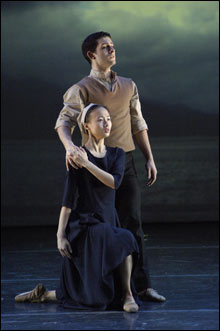
DARK ELEGIES: Clarity and respect, if not the weightiness that conveys tragedy. |
Two momentous revivals in town showed us how big the category of classical ballet really is. Over the weekend George Balanchine’s A Midsummer Night’s Dream (1962) completed its 10 performances at Boston Ballet, and Antony Tudor’s 1937 Dark Elegies was given four times at Boston Conservatory. Both works had multiple casts, so the dancers didn’t get much time to experience their roles.
You might think role playing isn’t the business of classical ballet. At least, that’s what George Balanchine is said to have believed. Actually, when it served his purposes, Balanchine was a wonderful storyteller and role creator; see his Nutcracker, Don Quixote, Coppélia, Pulcinella, or Prodigal Son.
Current critical and popular opinion favors Frederick Ashton’s streamlined, one-act The Dream, but lately I appreciate the Balanchine version more and more. His expansive two-act celebration of Shakespeare provides an antidote to the hyperactive, flavorless contemporary ballets we see everywhere. It invokes all the resources of a great ballet company: virtuosity, ensemble, acting, comedy, and the ability to create a poetic image. I thought the Boston Ballet dancers met this challenge admirably.
A Midsummer Night’s Dream is one of Balanchine’s variations on the traditional full-length-ballet formula. He tells the whole of Shakespeare’s complicated story in the first act, then gives us a second-act wedding celebration with a guest ensemble furnishing the entertainment. The music is all Mendelssohn: largely the descriptive, dramatic incidental music to the play for the first act, then string-symphony selections for the divertissement. The lovers’ contentiousness and mix-ups get resolved and then transformed into the pure classicism of the second act. Over both the real world of the mortals and the idyllic formalism of the divertissement hovers the supernatural realm of the fairies.
At the heart of all this, and linking together the ditzy mortals, the credulous rustics, the butterflies, bugs, fairies, and aristocratic celebrants, is the idea of the duet. Six or seven different pas de deux are strewn throughout the ballet, not only to explore variations on a given form but to convey character and states of mind. Never has the Balanchinian imagination been more tellingly deployed.
First off, after the introductory prologue, we get an extended pas de deux for Titania (Karine Seneca last Friday night) and a convenient Cavalier (Sabi Varga), accompanied by her retinue of fairies. They all seem to be running and leaping most of the time. There’s no suggestion of romance in this duet, it’s just an expression of joy and disinterested compatibility.
Taken to a higher level of perfection, the duet becomes an exquisite paradigm of harmony in the second act (Lorna Feijóo and Carlos Molina). Feijóo’s tendency to emphasize placement and transitions worked against the melting, legato changes that can make this duet so poignant, but just to see the choreography, so serene after all the turmoil, was a pleasure.
Titania and her consort, Oberon, never dance together — they’re absorbed in getting the better of each other most of the time — but when she wakes up, bewitched, and sees Bottom as a donkey (Gabor Kapin), she dances a duet with him that’s a parody of the classical model, set to Mendelssohn’s most ravishing love theme. The poor galumphing weaver-turned-beast is overwhelmed by this wondrous female who seems to be infatuated with him, but he tries to imitate the moves and supports she shows him. Balanchine’s framing of this farcical scene in a dance form that’s meant to symbolize ideal love puts another layer of feeling into the comedy.